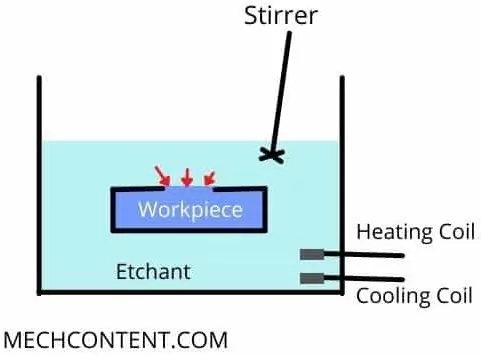What is Chemical Machining (CHM)?
Chemical machining is a machining process in which material removal carried out with the help of chemicals. These chemicals react with work-piece material and dissolves it.
It is one of the non conventional machining process.
Continue reading to know about its working process, construction, advantages, etc.
Contents:
Construction:
The below figure gives the basis idea of chemical machining.

Chemical Machining setup consists of the following components.
1) Chemical :- The chemical used in this process is also called as etchant. This chemical is responsible for the removal of the material from the work-piece.
It chemically reacts with the desired portion of work-piece material & dissolve it.
The types of etchants used in machining depends on the material of work-piece.
2) Cooling & Heating Coil :- The Cooling & Heating coil is used to maintain desired temperature of the chemical or etchant during the process.
3) Stirrer :- The stirrer helps in the mixing of the chemical or etchant.
Chemical Machining Working:
The chemical machining is done in following processes or steps :-
1) Cleaning :- In this step, the work-piece is cleaned using solvent to removes the dust, oil contaminants from the work-piece. It is necessary to clean, as the masking will not be done properly due to dust or oil contaminants.
2) Masking :- Masking is the process of applying the maskant or cover on the cleaned work-piece surface. This maskant or cover does not react with chemical or etchant.
It protects the covered portion of work-piece surface from being dissolved.
3) Scribing :- In this process, the maskant is removed from the portions of work-piece surfaces which has to be machined. It is done before the immersing work-piece in the chemical or etchant.
4) Etching :- In this process, the workpiece is immersed in the chemical or etchant. The chemical reacts with the work-piece surface where maskant is not present & dissolves this portion of the work-piece.
5) De-masking :- After the etching process, the remaining applied maskant is removed.
Therefore, in such way, chemical machining works.
Advantages of Chemical Machining:
- It produces high precision metal parts.
- It can machine any shape & size.
- Machining of work-piece from all sides at the same time.
- Less skilled labors can handle process
- High surface finish
- High machining accuracy
Disadvantages of Chemical Machining:
- Chemical solution used in this process is dangerous for human health.
- It is a slow process.
Applications of Chemical Machining:
- In drilling different sizes holes on plates.
- In machining of various automobiles parts.
Read also: